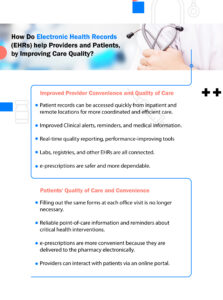How do electronic health records (EHR or EMR) improve the quality of care
There is a growing interest in EHRs around the world. Technology and innovations are changing the health industry, governments and organizations are focusing on providing better health services to the public.
Today, we’ll look at the world of EHRs or EMRs and how significant they are in the ever-changing world of modern health care.
Examining the health-care quality aspect of EHRs
You may be aware of EHR’s or EMR’s in recent times and how they are changing the health industry with their fast-paced functionalities and interoperability. EHR’s are conceptually designed for different purposes and they offer a huge advantage of collecting and maintaining the patients’ medical information in electronic formats.
EHRs contain a wide range of patient-level variables such as diagnoses, demographics, vital signs, problem lists, medications, and laboratory data. It is a key tool that performs a variety of core functions such as health information capture, clinical decision support, health information exchange, patient support, electronic communication, orders and results management administrative processes, and population health reporting.
Electronic health records provide all the essential information and meaningful patient data that helps in providing positive health outcomes. In present times doctors and clinics are better equipped to treat the patients and meet their expectations, and readily available valuable data from the EHR systems will help contribute to easier clinical decision making.
Better analysis and information
EHR’s provides better and more detailed information about the patients that were not previously possible with paper charts. Primary care providers can acquire accurate analysis by viewing or printing graph values such as cholesterol levels, blood pressure, and weight by tracking all the changes over time. The EMR data will help primary care providers to develop a better care plan for chronic diseases, management, prevention, and screening. Point-of-care data from EMRs can be used to inform practice and conduct research. The EMR data provides the physician with valuable practice-level information when used meaningfully, which includes standard and consistent data entry in specific fields.
Positive effects on workflow
The EMR allows clinicians to see a greater number of patients by providing better access to comprehensive patient histories that include clinical data, potentially saving physicians time searching for results and reports. Remote access to patient charts, improved laboratory result availability, medication error alerts, and preventive care reminders are among the perceived benefits.
Aids physicians in focusing on preventive care
Improved versions of today’s EHRs have helped healthcare providers manage preventable diseases more effectively. They can use EHRs to send electronic templates to patients, prompting them to schedule appointments for procedures such as mammograms, colonoscopies, and other exams. These precautions can help in the early detection of potentially fatal diseases like breast cancer. Doctors can stay on top of their patient’s health by being on a high alert for patients who still have not had important screening tests.
EHRs give caregivers the tools they need to spot patient risks and behaviors, resulting in better preventive care. It also allows doctors to focus on patients rather than numbers, which improves the quality of care and treatment outcomes.
Better Patient Outcomes
In the emergency room, hospitals, clinics, and other healthcare facilities, doctors are frequently the only point of contact for patients. When data isn’t recorded and available to all staff, it leads to fragmented data and misinterpretations. Thanks to EHRs, administrators can virtually monitor a patient’s health. This improves patient outcomes by improving access to healthcare data and care coordination.

The Positive Impact of EHRs in the Healthcare industry
EHRs are significantly transforming the healthcare industry; they contain patient-centered records containing medical and treatment histories of patients that are only accessible to authorized users.
Because of its safe and compatible features, and elaborate reports, it is an ideal instrument for health practitioners and labs to provide a comprehensive and broader view of the patient’s care.
So, how do EHRs improve the quality of care, you might ask?
Well, EHR systems are designed to go beyond the standard clinical data collected in a physician’s office.
Here are some of the key points that EHRs deliver in the field of healthcare and medicine.
Improved Patients care
Aside from making healthcare providers’ lives easier, they also improve patient care and safety. EHRs make more valuable data available to providers and aid in clinical data management. They also help to streamline clinical decision-making and time-consuming processes.
Patients may see multiple doctors, ranging from cardiologists to dermatologists. Every doctor a patient sees must have the same knowledge. EHRs ensure that every provider in the patient’s network of care is aware of which medications they are taking as well as any other treatment plans. EHRs also offer the convenience of electronic prescriptions sent to pharmacies and the elimination of the need to fill out the same forms at each doctor’s visit.
EHRs put accurate and complete information about patients’ health and medical history at the fingertips of providers. With EHRs, caregivers can provide the best possible care at the point of care. This can result in a better patient experience and, more importantly, better patient outcomes. That is how EHRs help in improving patient care by delivering high-quality treatment.
Increase Patient Participation
EHRs authorize providers and patients to share access to electronic health information and collaborate on making informed decisions. Patient involvement is especially important for treating chronic conditions such as asthma, diabetes, and obesity.
EHR-enabled patient portals give patients access to critical healthcare information. EHRs deliver patients with access to current medical records and enable them to review notes or treatment results in near real-time. Many also allow patients to send messages to providers through a secure system.
Providers may be able to identify symptoms earlier if patients and providers can communicate quickly and easily. It can also position providers to be more proactive in their patient outreach. Patients can also access information from their providers via patient portals linked to their EHR system.
Improved Care Coordination
As medical and technological practices have evolved with time. The need for better and improved coordinated care has increased. The team of healthcare providers consists of primary care physicians, specialists, nurses, technicians, and other clinicians.
Depending on each team member’s area of expertise, each member of the team has specific or limited interactions with the patient and has a unique perspective on the patient. The healthcare team’s view of the patient can become tangled up with disconnected facts and symptom clusters.
Care coordination can be improved with electronic health record (EHR) systems, reducing fragmentation of care. EHRs have the potential to integrate and organize patient health information and make it available to all authorized providers involved in a patient’s care in real-time.
As previously stated, a patient may see several providers, ranging from primary care to specialists. EHRs can help with care coordination. Whether patients require a large care team or just a single provider, an EHR will improve the care provided by the healthcare team. Obstacles can also be resolved by increasing productivity and reducing workload in the direct proximity of a patient.
Improved Diagnostics & Patient Outcomes
When healthcare providers have complete and accurate information, patients benefit from better medical care. EHRs improve the ability to diagnose diseases and reduce, if not eliminate, medical errors, resulting in better patient outcomes. EHRs give doctors and nurses access to a patient’s entire medical history. The healthcare team can use this comprehensive picture to diagnose patients’ problems faster.
EHRs can alert providers when potential safety issues arise, allowing them to avoid more serious consequences for patients and resulting in better patient outcomes. When a new medication is prescribed, an EHR keeps track of the patient’s medications and allergies while still checking for potential conflicts and informing the clinician. for example, a primary care provider’s information is stored in an EHR. It notifies an emergency room clinician of a patient’s life-threatening allergy, allowing caregivers to make better decisions.
Efficiencies in Medical Practice and Cost Savings
EHRs aid in the improvement of medical practice management by increasing efficiencies and lowering costs. Better disease management and patient education resulted in improved patient health and care quality. Electronic health records have proven to be a cost-cutting tool for healthcare providers.
Some of the efficient medical practices that were facilitated by EHR’s are
- Integrated scheduling systems that link appointments directly to progress notes, automate coding and manage claims have all been improved.
- With easier centralized chart management, condition-specific queries, and other shortcuts, you can save time.
- Public health systems, such as registries and communicable disease databases, are easily accessible.
- Patient information is easily accessible from any location.
- Electronic messages to staff, other clinicians, hospitals, labs, and other entities are tracked.
- Health plans’ formulary checks are automated.
- Lab tests and diagnostic images are ordered and received.
Medical cost savings were also boosted by the ability to meet key regulatory requirements such as:
- Physician Quality Reporting Initiative (PQRI) alerts physicians when key regulatory data elements are missing.
- Time and resources required for manual charge entry are reduced, resulting in more accurate billing and fewer lost charges.
- Charge lag days and vendor/insurance denials associated with late filing are reduced.
- Charge review edits notify doctors if a test can only be performed at a specific frequency.
Finally, a few words about electronic health records (EHRs) and their success
Electronic medical records have been shown to improve workflow efficiency by reducing the time needed to retrieve charts, improving access to comprehensive patient data, assisting with prescription management, improving patient appointment scheduling, and allowing remote access to patients’ charts. In the future, more institutions will support the use of EHR’s to provide comprehensive and inclusive care for their patients.








